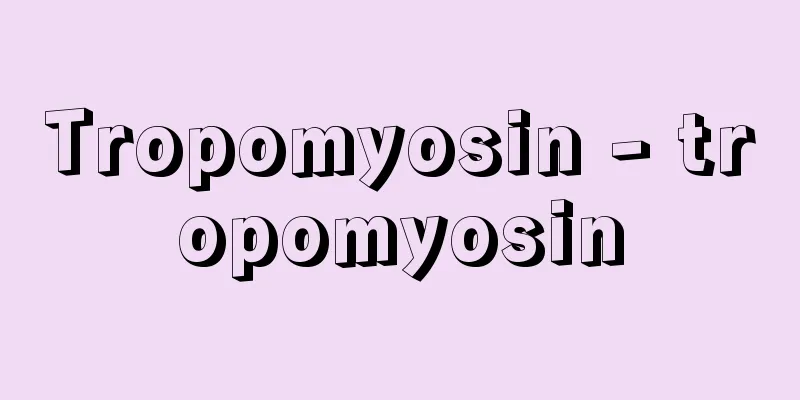Tropomyosin - tropomyosin

|
One of the regulatory proteins in skeletal muscle. Together with troponin, it regulates the contraction and relaxation of skeletal muscle. It was discovered in 1946 by British biochemist Kenneth Bailey (1909-1963) and crystallized in 1948. It is composed of two subunits, αα (alpha alpha) or αβ (alpha beta), with 284 amino acid residues and a molecular weight of about 34,000, and exists with a molecular weight of about 68,000. Most of them are thin rod-shaped molecules with α-helices (one of the stable helical structures that a polypeptide chain can have), and are 1.5 to 2 nanometers wide (1 nanometer is one billionth of a meter) and 40 nanometers long. They bind to the grooves of the twisted double helix of actin filaments one by one, stabilizing their structure. They also bind to troponin, a calcium-receptor protein, to make actin calcium-sensitive and regulate the binding of actin to myosin. A one-to-one complex of troponin and tropomyosin is called active tropomyosin, and when seven times as much actin is added to it, it becomes the composition of thin muscle filaments. Troponin was discovered and isolated (1964) by Setsuro Ebashi (1922-2006) and his wife Fumiko, as a protein that gives Ca2 + sensitivity to actomyosin ATPase activity. It is a protein with a molecular weight of about 75,000 and is composed of three subunits, T, I, and C. Tropo is a prefix derived from the Greek word tropos, which means change or bending. [Koji Nomura] "Comparative Biochemistry of Muscle Proteins of Marine Animals" edited by Kenichi Arai (1989, Kouseisha Kouseikaku) " "Fish and Shellfish Muscle Proteins: Their Structure and Function" edited by Kiyoyoshi Nishida, supervised by the Japanese Society of Fisheries Science (1999, Kouseisha Kouseikaku)" [References] | | | | | |©Shogakukan "> Muscle structure Source: Shogakukan Encyclopedia Nipponica About Encyclopedia Nipponica Information | Legend |
|
骨格筋にある調節タンパク質の一つ。トロポニンとともに骨格筋の収縮弛緩(しかん)を調節するタンパク質。イギリスの生化学者ベイリーKenneth Bailey(1909―1963)が1946年に発見し、1948年に結晶化した。アミノ酸284残基、分子量約3万4000のサブユニット二つ、αα(アルファアルファ)またはαβ(アルファベータ)の構成で、分子量約6万8000で存在する。ほとんどがα-ヘリックス(ポリペプチド鎖がとりうる安定な螺旋(らせん)構造の一つ)の細い棒状の分子で、幅1.5~2ナノメートル(1ナノメートルは10億分の1メートル)、長さ40ナノメートルの大きさである。アクチンフィラメントのねじれた二重螺旋の溝に沿って1本ずつ結合し、その構造を安定化している。また、カルシウム受容タンパク質であるトロポニンと結合して、アクチンにカルシウム感受性を与え、アクチンとミオシンの結合を調節する。トロポニンとトロポミオシンの1対1の複合体は活性トロポミオシンとよばれ、これに7倍のアクチンが加わると細い筋フィラメントの組成になる。トロポニンはアクトミオシンATPアーゼ活性に、Ca2+感受性を与えるものとして江橋節郎(えばしせつろう)(1922―2006)・文子夫妻によって発見、単離された(1964)。分子量約7万5000のタンパク質でT、I、Cの三つのサブユニットからできている。なお、トロポとはギリシア語の変化、屈折を意味するトロポスからきた接頭語である。 [野村晃司] 『新井健一編『水産動物筋肉タンパク質の比較生化学』(1989・恒星社厚生閣)』▽『日本水産学会監修、西田清義編『魚貝類筋肉タンパク質――その構造と機能』(1999・恒星社厚生閣)』 [参照項目] | | | | | |©Shogakukan"> 筋肉の構造 出典 小学館 日本大百科全書(ニッポニカ)日本大百科全書(ニッポニカ)について 情報 | 凡例 |
Recommend
Kashima Nishiki
A regional brand of Kyushu, Okinawa region, and Sa...
Araki Jogen
A Western-style painter from Nagasaki in the late...
Theology - Shingaku
An academic field that discusses the content, obj...
Metallic Pigments - Metallic Pigments
...The fine powder of carbon contained in lamp bl...
Nabū-naid (English spelling)
…reigned 555-539 B.C.; more precisely, Nabū-naid....
long tailed skua
...They breed in the northern part of the Norther...
Mary Wollstonecraft
British thinker. She was the first in history to ...
Kidd, B.
...However, historically, the distinction between...
Carothers
American chemist. Born in Burlington, Iowa. After ...
Tropical medicine - Tropical medicine
A branch of medicine that studies the pathology an...
legend
…Of all the myths, legends are recognized as havi...
Sentoku
A haiku poet of the mid-Edo period. Mizuma, who w...
Kihejima ruins - Kihejima ruins
...In areas such as the Setouchi region, records ...
Ostracoda
…the name of the crustaceans belonging to the sub...
Chapaev, VI (English spelling) ChapaevVI
...In April, they advanced to within 80 km of Kaz...









